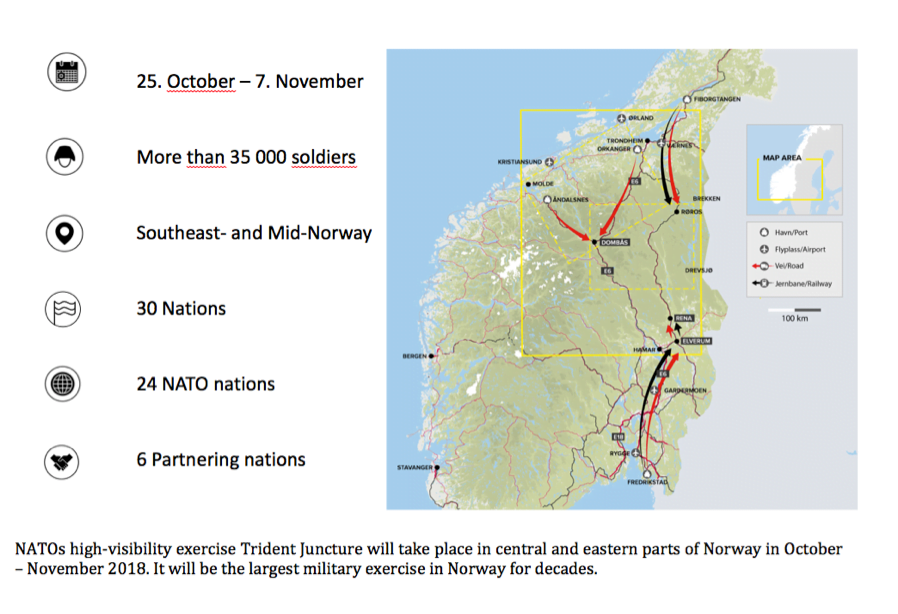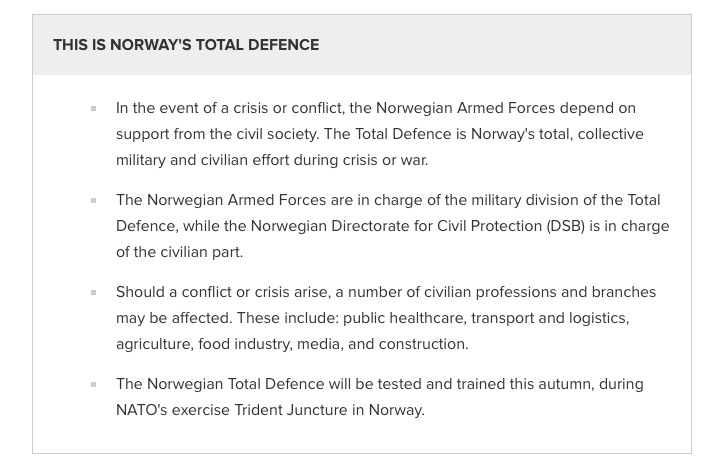Around 90 US Marines from the 24th Marine Expeditionary Unit landed at Keflavík on Wednesday (17 October 2018), marking the initial phase of NATO’s Exercise Trident Juncture 2018 in Iceland.
The main phase of Trident Juncture will start in Norway on October 25. Arriving by MV-22 Osprey and CH-53 Sea Stallion helicopters from the USS Iwo Jima, the Marines practised securing the airfield and key infrastructure, in cooperation with the Icelandic Police.
The US Navy has also deployed two cutting-edge P-8A Poseidon aircraft to Keflavík from their current home in Sigonella, Italy.
In remarks at the Vardberg Association on Tuesday, Admiral James G. Foggo, Commander of Allied Joint Force Command Naples, as well as US Naval Forces in Europe and Africa, highlighted the P-8A’s key role in anti-submarine operations. He stressed the aircraft’s world-class surveillance and intelligence capabilities, which are important for NATO in the North Atlantic.
Foreign Minister Gudlaugur Thor Thordarson and Admiral Foggo showcased Iceland’s vital role in the NATO Alliance.
Speaking at a ceremony commemorating the Battle of the Atlantic aboard the Icelandic Coast Guard Vessel THOR, Minister Thordarson highlighted the “crucial” importance of “unimpeded shipping routes over the Atlantic”. Admiral Foggo also noted Iceland’s strategic location, and thanked the country for an “unwavering commitment” to its Allies.
Trident Juncture 2018 is NATO’s largest exercise in many years, bringing together around 50,000 personnel from all 29 Allies, plus partners Finland and Sweden. Around 65 vessels, 150 aircraft and 10,000 vehicles will participate.
The featured photo shows a USMC Osprey landing at Keflavik with a Canadian c-17 on the tarmac.
During a visit to Norway earlier this year, in our interview with a senior Norwegian military officer involved in shaping the exercise, the focus of the Norwegian effort was highlighted. That interview published in May 2018 follows:
Seen from a Nordic perspective, the exercise is coming at a time when Norway is modernizing its defense force, working ever more closely with the other Nordics, including cross-border training with Sweden and Finland, and re-invigorating its total defense approach.
Indeed, with the return of conscription in Sweden, with the continued commitment to a national mobilized armed forces in Finland and to a re-emphasis on the total defense concept, the Nordics are leading the way within Europe on a wider societal commitment to defense.
With the importance of crisis management in the region, an ability to work effectively with allied forces operating on NATO territory supported by a total defense approach within Norway, is part of the effort to calibrate force capabilities appropriate to deal with regional crises.
As Norway reworks its air basing structure, and modernizes its air force, army and navy, along with changes in the broader North Atlantic, working deterrence in depth is underway as well.
For example, the UK will add a new F-35-enabled carrier able to operate in the region as a mobile base able to work with other F-35s in the region to shape a wider combat grid to support moves on the strategic and tactical chessboard necessary to deal with regional crises.
But to shape such capabilities will require an effective exercise regime, one in which Norway works to support allied forces appropriate to meeting effectively specific regional crisis situations.
It is not just about being reassured by importing allied capability, more generally; it is about integrating Norwegian with appropriate allied forces to meet specific crisis management challenges and military threats in the region.
 Col Lars Lervik at the Norwegian Ministry of Defence is working the preparation for the Trident Juncture 2018 exercise and according to him:
Col Lars Lervik at the Norwegian Ministry of Defence is working the preparation for the Trident Juncture 2018 exercise and according to him:
“A key focus of the exercise from the NATO side is exercising our ability to conduct high intensity operations in a multi-national environment.
“What we’re looking at here is confronting an opponent who has the whole arsenal available.
“We need to be able to function not only as individuals and individual nations, but actually function together.
“This is a key focus of the exercise.”
Trident Juncture 2018 is also a command post exercise as well and given that Norway is reworking its C2 capabilities as part of defense modernization, the exercise provides an opportunity to input multinational operational training as well into the transformation process.
Col Lars Lervik highlighted that “It is very important to ensure that we have the procedures in place necessary to operate an integrated force on Norwegian territory in a higher intensity operational environment.
“We are starting really to be serious about C2 again.
“We are working to shape an effective C2 template going forward.
“We need to make sure that all our structures are integratable with NATO.”
“It is not a coincidence that Norway volunteered to be the host for this exercise.
“We’ve been focused on getting NATO to focus back on collective defense for quite a while.”
The Norwegians are working at three levels with regard to C2.
The first is at the national level.
The second is at the NATO level.
The third is at the bilateral C2 level, namely working with the US, the UK, the Nordic non-NATO members as well as other NATO members, such as Germany.
There is a substantial maritime component within the exercise, which gets at the broader extended deterrence piece whereby the sea base becomes integrated into the defense of Norway and NATO forces operating on Norwegian territory as well.
Col Lars Lervik underscored that “Working with allied forces is also about the capability of Norway able to receive NATO and allied reinforcements.
“And that’s when a total defense concept comes into play for us to be able to fulfill our host nation support commitments.”
For Norway, the total defense concept is a focus on the ability of the civilian side of society to support military operations.
For example, the Norwegians do not have a specialized military medical service. The civilian side is mobilized to support both Norwegian and allied medical needs in times of conflict. This will be exercised during Trident Juncture 2018.
Col Lars Lervik emphasized that “We need to be able to support NATO allies when they come into Norway.
“I think we’re making real progress with regard to civil society’s ability to support the Norwegian and allied militaries.
“For example, when the US Marines arrive in Undredal, Norway (in the middle of Norway), it could be a civilian bus driver on a civilian bus who will transport them onward to their next location. They might pick up fuel from a local civilian Norwegian logistics company.
“It is about the resilience as well with regard to civilian society to support military operations.
“We need to understand and to enhance how the modern society is able to function in a time of crises and war.”



